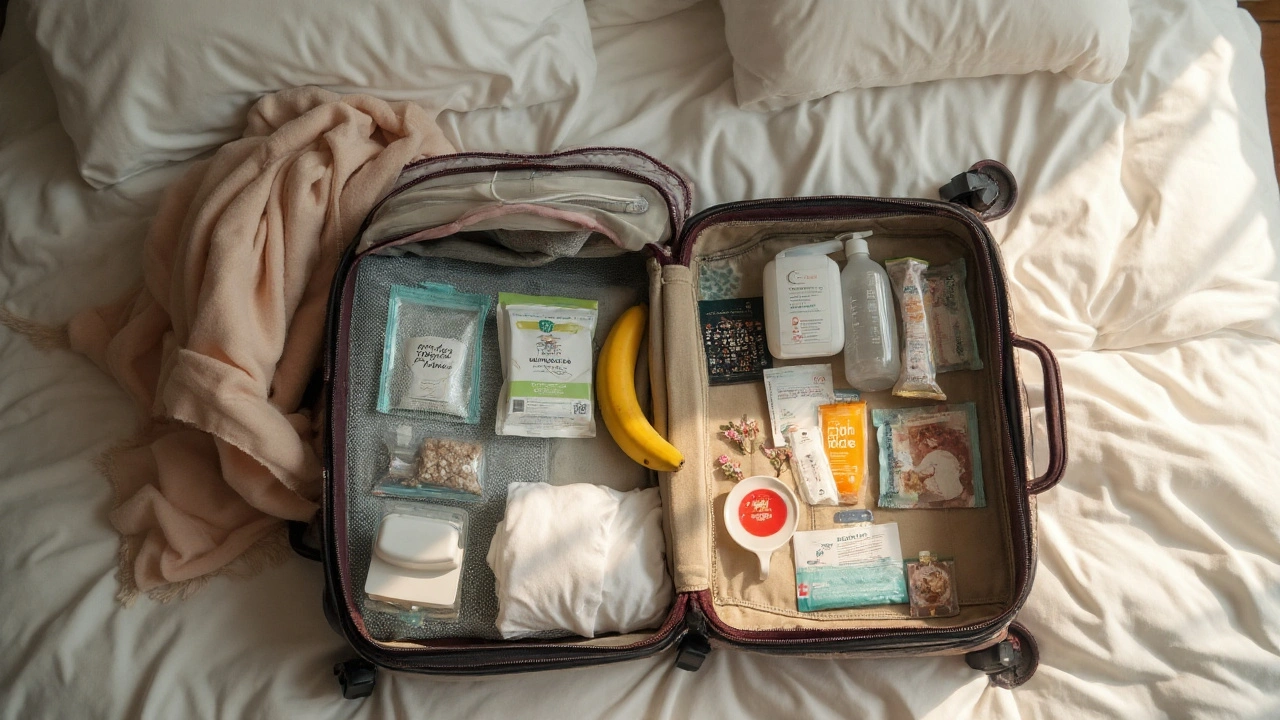Travel shouldn’t be a gamble with your gut. You want a realistic plan that reduces panic, keeps you hydrated, and gets you from door to door without derailing your itinerary. I live in Bristol and travel a fair bit with my son, Tarquin, and I’ve learned the hard way that good prep beats willpower every time. This guide gives you a clear packing list, evidence-backed meds, food and water rules that actually matter, and a simple SOS plan for flares. You won’t control everything, but you can stack the odds in your favour.
TL;DR
- Build a two-bag setup: a quick-access pouch (meds, wipes, ORS, spare underwear) and a backup kit (extra meds, barrier cream, clothes) in your main bag.
- First-line meds: loperamide for symptom control; ORS for hydration; bismuth subsalicylate for mild control and nausea. Ask your clinician about stand-by antibiotics if you’re high risk.
- Eat low risk: cooked, hot, peeled, or packaged. Avoid tap water, ice, salad, buffets in higher-risk regions. Use bottled water with intact seals.
- Pick aisle seats near toilets, use airport sunflower lanyards (hidden disability), and declare pre-existing conditions on travel insurance.
- Red flags: blood in stool, fever, severe pain, dehydration, or symptoms lasting >48 hours despite treatment-seek medical care.
Jobs you likely need done
- Pack the right meds and supplies-no dead weight.
- Plan planes, trains, and road trips with fast toilet access.
- Eat and drink without inviting trouble.
- Handle a flare mid-trip without losing a whole day.
- Know when to self-manage and when to get help.
Quick answer and core plan
You clicked for a practical blueprint, so here’s the backbone. This is the same structure I use when I travel with a sensitive gut and a kid in tow.
1) Your meds game plan
- Loperamide (Imodium): good for urgency and frequency. For adults, common guidance in the UK is an initial 4 mg, then 2 mg after each loose stool, up to a daily max per local label (often 16 mg on prescription; OTC limits can be lower). Do not exceed label limits-very high doses can affect heart rhythm. Avoid in acute dysentery (blood/high fever).
- Bismuth subsalicylate (e.g., Pepto-Bismol): helpful for mild diarrhea and nausea; can darken stool/tongue. Avoid if you’re allergic to aspirin/salicylates, pregnant, breastfeeding, or giving to children/teens due to Reye’s risk. Check interactions if you’re on anticoagulants.
- Oral rehydration salts (ORS): not glamorous, but they keep you functioning. WHO-formulated sachets replace salts and glucose in the right ratio. Sip steadily; don’t chug. If you’re in a pinch, use a reputable sports drink and add a pinch of salt, but proper ORS is better.
- Stand-by antibiotics: Not for everyone. In 2024-2025, many clinicians favour azithromycin for severe traveler’s diarrhea, especially in Asia where quinolone resistance is common; rifaximin may help for non-invasive cases. Discuss with your GP or gastro team if you’ve got IBS-D, bile acid diarrhea, or IBD and tend to spiral on trips. Don’t start antibiotics for every loose stool-reserve for severe symptoms (e.g., ≥3 unformed stools in 8 hours plus fever, blood, or significant disability).
- Condition-specific meds: If you’ve got bile acid diarrhea, ensure adequate cholestyramine/colesevelam. For IBD, carry your regular meds, a steroid rescue plan if prescribed, and a letter describing your regimen. For IBS-D, some people benefit from specific probiotics (e.g., Saccharomyces boulardii) started 5-7 days before departure; evidence is mixed but better for traveler’s diarrhea prevention than for chronic flares.
2) Two-bag setup that saves your day
- Grab pouch (under-seat bag): blister strips of loperamide and bismuth, 2 ORS sachets, tissues, unscented wipes, small barrier cream (zinc oxide), spare underwear, fold-flat bag for soiled clothes, hand gel, deodorising baggie, and a travel bidet or squeeze bottle if that helps your skin.
- Main kit: extra ORS (6-10 sachets), more meds, electrolyte tablets for taste, soft toilet paper, second set of clothes, dark joggers/leggings, light jumper, rehydration bottle with volume markings, and a tiny spray for odour control.
3) Seat, sleep, and stress
- Aisle seat near the loo: worth any small extra fee. On short-haul, rows near the rear galley often have faster toilet access. On long-haul, map the lavs before boarding.
- Hidden disability support: UK airports recognise the sunflower lanyard; it can speed security and boarding, and staff are usually kinder if you need a quick run to the toilet.
- Sleep: jet lag and poor sleep raise gut sensitivity. Start shifting your bedtime by 30-60 minutes for a few days pre-flight and keep caffeine low the travel day.
4) Food and water rules that matter
- Prefer food that is cooked and hot, or peeled, or factory-sealed.
- Water: in higher-risk regions, use bottled water with intact seals for drinking, brushing teeth, and making ice. Avoid fountain drinks and buffets. If you can’t find bottles, boil water for 1 minute.
- On travel day: stick to low-FODMAP-ish choices you tolerate-plain rice, eggs, grilled chicken, oats, bananas, lactose-free yoghurt. Save the local food adventure for day two when you’re settled.
5) Insurance and documents
- Declare your pre-existing condition to your travel insurer, or claims get messy. In Europe, carry a GHIC for state care, but still buy travel insurance for extras like evacuation.
- Keep meds in original packaging with a doctor’s letter if carrying controlled or prescription-only items (rules vary by country; codeine and diphenoxylate can be restricted).
Authoritative sources backing this general approach include NHS guidance on diarrhea and rehydration, WHO advice on ORS and water safety, and CDC travel health recommendations on traveler’s diarrhea and antibiotics. Your clinician’s advice always takes priority for your specific condition.
| Item | Use | Typical Adult Notes |
|---|---|---|
| Loperamide | Urgency/frequency control | Start 4 mg, then 2 mg after each loose stool; respect local max per label. Avoid if blood/high fever. |
| Bismuth subsalicylate | Mild diarrhea, nausea | Short-term use; avoid with salicylate allergy, pregnancy, breastfeeding, children/teens. |
| ORS sachets | Rehydration | Mix as directed; sip steadily. Aim for 200-250 ml after each loose stool. |
| Azithromycin (stand-by) | Severe traveler’s diarrhea | Use only if clinician-advised. Typical single dose 1 g or 500 mg daily x 1-3 days for severe cases. |
| Rifaximin (stand-by) | Non-invasive diarrhea | May help if no blood/fever. Use only per prescription guidance. |
| Zinc oxide cream | Skin protection | Apply thin layer after cleaning to reduce soreness. |

Step-by-step travel playbook
This is your end-to-end plan-from the week before you go to the moment you land.
A week before
- Confirm diagnosis and stability: If you’ve got IBS-D, bile acid diarrhea, or IBD in remission, make sure you’re on your stable regimen. If you’re flaring, talk to your clinician before locking flights.
- Med check: Refill prescriptions. Ask about stand-by antibiotics if you frequently tip into severe diarrhea while away. If you use probiotics, start the strain you tolerate now (some use S. boulardii).
- Insurance and letters: Buy travel insurance and declare your condition. Ask your GP for a simple medication letter. Check destination rules for controlled meds.
- Vaccines: For IBD or immunosuppressed travellers, confirm vaccine status with your team; live vaccines may be restricted. Routine travel vaccines are still vital.
- Toilet access tools: If in the UK, get a Just Can’t Wait card (Crohn’s & Colitis UK) and consider a RADAR key for accessible toilets. Pack the airport sunflower lanyard if you use one.
Three days before
- Diet dial-down: Ease into simpler foods you tolerate-white rice, lean protein, oats, bananas. Cut back on alcohol, chilli, and high-fat meals.
- Sleep shift: Slide bedtime by 30-60 minutes toward your destination time zone. Your gut likes routine.
- Pack your two-bag setup: Confirm duplicates of essentials across bags in case one gets separated.
Travel day
- Eat safe and light: Breakfast could be oats with banana and lactose-free milk; later, a grilled chicken wrap without sauce. Sip water; avoid giant coffees.
- Pre-board prep: Use the toilet just before boarding. Know where the onboard loos are. If you wear the sunflower lanyard, let staff know discreetly.
- In-flight routine: Small sips frequently; one ORS if you’ve had recent looseness. If urgency hits, loperamide per label. Stand and stretch to keep things calm.
- Arrival hygiene: Wash with soap and water before meals-alcohol gels don’t work well against norovirus. Keep nails short for easier hand cleaning.
On the ground
- First meal: Choose something cooked-to-order and hot. If you’re eyeing street food, watch vendors cook from fresh and pick the busiest stall with high turnover.
- Hydration pace: Target urine the colour of pale straw. If you go loose twice in a row, add an ORS.
- Hotel setup: Ask for a room near lifts and close to the lobby toilets if that lowers your stress. Keep a small towel, wipes, and barrier cream ready by the bathroom.
- Excursions: Sit aisle on coaches, map toilets on your route (Google Maps reviews often mention them), and pack your grab pouch. Many museums and attractions list toilet locations online.
Food and drink cheat-sheet
- Usually safer: boiled rice, potatoes, grilled meats, eggs, soups that arrive piping hot, peeled fruit (bananas, oranges), sealed yoghurt you tolerate, plain crackers.
- Riskier: salad leaves washed in tap water, ice cubes, buffets with lukewarm trays, undercooked meats, unpasteurised dairy, smoothies from rinsed blenders, sashimi if hygiene is uncertain.
- FODMAP awareness: onions, garlic, and certain beans can trigger IBS-D even if hygiene is perfect. Ask for sauces on the side. Many cuisines can still work-tandoori chicken, grilled fish, rice bowls, pho with simple toppings.
SOS for a flare
- Step 1: Slow things down: Loperamide as per label. If you use bismuth, take a dose. Pause food for 2-4 hours.
- Step 2: Rehydrate: Start ORS-small sips every few minutes. Skin care with wipes and zinc cream to prevent soreness.
- Step 3: Reintroduce: Bland, low-fat foods: rice, bananas, simple broth, plain toast. Avoid alcohol and caffeine for 24-48 hours.
- Step 4: Escalate if needed: If you meet your clinician’s criteria for stand-by antibiotics (e.g., severe symptoms plus fever or blood), start the prescribed course.
Red flags demanding medical care: blood or black stools, high fever, severe constant abdominal pain, signs of dehydration (very dark urine, dizziness, confusion), more than 48 hours without improvement, or if you’re immunocompromised. NHS, CDC, and WHO flag these as reasons to seek prompt care.

Checklists, FAQs, and what-ifs
Bookmark this section. It’s the quick reference that saves you at 2 a.m. in a hotel bathroom.
Packing checklist (carry-on)
- Loperamide in blister packs
- Bismuth subsalicylate chewables or liquid
- 4 ORS sachets (plus 6 more in checked bag)
- Small zinc oxide barrier cream
- Unscented wipes + tissues
- Spare underwear + dark leggings/joggers + fold-flat laundry bag
- Hand gel and soap leaves; deodorising baggies
- Travel bidet/squeeze bottle (optional but great)
- Med letter, insurance details, Just Can’t Wait card, sunflower lanyard
Hotel/road add-ons
- Extra ORS, electrolyte tabs for flavour
- Soft toilet paper, small towel, barrier spray
- Thermal flask for safe hot drinks
- Snacks you tolerate: oat bars, plain crackers, lactose-free UHT milk
Rules of thumb that prevent most meltdowns
- Two consecutive loose stools? Start ORS. Don’t wait for dizziness.
- One new dish at a time. If it backfires, you’ll know the culprit.
- Seat near toilets beats extra legroom when your gut is jumpy.
- Soap and water beat alcohol gel for the bugs that cause explosive diarrhea.
- Don’t stack meds randomly. Start with loperamide or bismuth, not both at high doses.
Mini-FAQ
- Can I take loperamide every day on a trip? For chronic conditions like IBS-D or bile acid diarrhea, some people use scheduled low doses under clinician guidance. For travel, many use it as needed. Stick to label limits and get medical advice for daily use.
- Is dairy a guaranteed problem? Not always. If lactose is an issue, use lactose-free products or carry lactase tablets. Hard cheeses and yoghurt with live cultures may be easier than milk.
- Do probiotics actually help? Some evidence supports S. boulardii and a few Lactobacillus strains for preventing traveler’s diarrhea, less so for chronic flares. If you tolerate a specific strain, start a week before travel.
- What if I’m on immunosuppressants for IBD? Be stricter with food and water safety, keep vaccines up to date (avoiding live vaccines if advised), and seek care earlier if you develop fever or persistent symptoms.
- How much should I drink? Aim for pale straw-coloured urine. In heat, that may mean 2-3 litres/day, using ORS if you start going loose.
- What about kids? This guide focuses on adults with chronic diarrhea. For children, dosing and red flags differ-follow paediatric advice and avoid loperamide under age thresholds unless a clinician says otherwise.
What if scenarios
- What if I’m stuck in the middle seat? Ask the gate agent for an aisle citing a medical reason; many will move you if a seat exists. Failing that, pre-empt with bathroom trips and keep your pouch in your lap.
- What if I forgot ORS? Buy sachets at a pharmacy or make a basic mix: 6 level teaspoons sugar + 1/2 level teaspoon salt in 1 litre of safe water. Accuracy matters; too much salt or sugar is harmful.
- What if I can’t trust bottled water? Boil for 1 minute or use a filter plus chemical disinfection (check your filter’s specs). Let water cool before adding ORS.
- What if I’ve got butt-burn from frequent wiping? Use a travel bidet or pour bottle, pat dry, then apply zinc oxide. Switch to soft, damp tissues. Brief air-drying helps.
- What if antibiotics always wreck me? Discuss rifaximin or azithromycin strategies with your clinician and pair with ORS. Consider probiotics you tolerate. Only use antibiotics when criteria are met.
When to seek help (quick reference)
- Blood in stool or black, tarry stools
- Fever ≥38.5°C with severe diarrhea
- Severe, worsening abdominal pain
- Signs of dehydration: very dark urine, dizziness, fast heartbeat, confusion
- No improvement after 48 hours of self-care
- If you’re elderly, pregnant, or immunocompromised-seek care sooner
Evidence and guidance
This playbook lines up with NHS guidance on diarrhea management and ORS use, WHO recommendations on water safety and rehydration, and CDC traveler’s health advice on food/water safety and antibiotic indications (2024-2025 updates). NICE guidance supports loperamide in IBS-D, with tailored use based on symptom control. For bile acid diarrhea, bile acid binders remain core therapy. Your exact dosing and rescue plans should come from your GP or gastroenterologist.
Personal note
As a dad who’s had to juggle a jittery gut, a buggy sleeper, and a tight connection at Schiphol, I can tell you this: the confidence boost comes from knowing you can handle a setback. The spare clothes in your bag aren’t pessimism-they’re freedom to say yes to the trip.
Next steps and troubleshooting
- If you’re IBS-D dominant: trial a low-dose loperamide schedule under clinician guidance just for travel days; pair with a simple diet and planned toilet access. Consider S. boulardii starting a week prior.
- If you have bile acid diarrhea: take your binder consistently and split doses if your clinician agrees. Pack extra sachets in case meals run fatty.
- If you have IBD in remission: stick to your maintenance meds, carry your steroid rescue plan if prescribed, and be conservative with food and water. Seek care early with blood/fever.
- If anxiety drives urgency: learn two quick tools-box breathing (4-4-4-4) and a 5-minute walk before boarding. Consider talking therapy or short-term meds with your GP before big trips.
- If you’re heat-exposed: double down on ORS, hats, shade, and salted snacks. Heat plus diarrhea dehydrates fast.
Keep this core line in your head: with traveling with chronic diarrhea, the win isn’t zero symptoms-it’s staying mobile, hydrated, and in control. Pack smart, choose food that loves you back, and use meds with intention. That’s how you make your trip smooth enough to actually enjoy it.

Akinde Tope Henry
September 5, 2025 AT 19:14